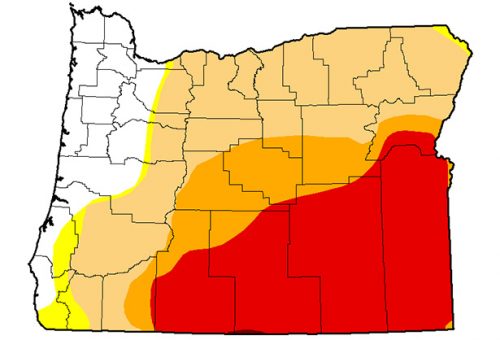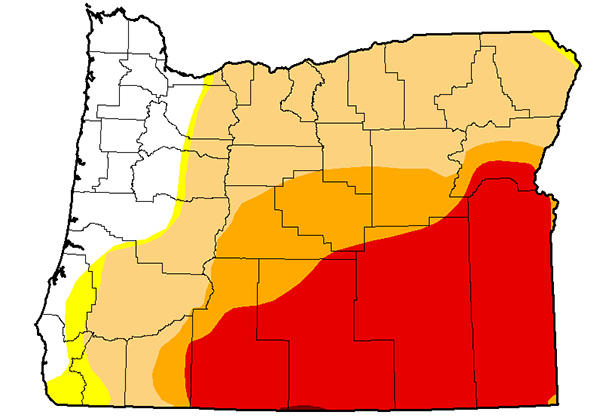
Frogs really don’t stay in a pot of slowly boiling water and die. Given a chance to jump out, they will. That anecdote has been used endlessly to describe people who simply don’t react to negative changes if they happen gradually. And it would be a useful one to describe Oregonians and our changing climate … if it were true.
Slow boiling frogs might be apocryphal, but our changing climate is real.
Gov. Kate Brown has declared a drought in five Oregon counties. The U.S. Drought Monitor says 1,523,378 Oregonians are affected by drought and 34 percent of Oregon is in extreme drought, 14 percent is in severe drought and 34 percent is in moderate drought — and the map shows that includes almost half of Lane County. Yet here in the Willamette Valley very few of us are pondering taking shorter showers or what this means for our water supply, especially as it rains outside.
 |
|
Most of Oregon is experiencing abnormally dry to Extreme drought conditions, according to the U.S. Drought Monitor. the darker regions indicate drought conditions. Illustration courtesy Michael Brewer, NCDC/NOAA.
|
Drought isn’t just a lack of falling rain. In Oregon, it’s our snowpack — more precisely, the amount of water that fell and is retained as snow that slowly melts over the course of warming spring and summer weather and allows our rivers to flow all year.
Oregon had plenty of precipitation, according to recent data from the April “Oregon Basin Outlook Report,” but it wasn’t snow, and February’s warm rains washed away what snow we had. This leaves us with snowpack across the state of eight to 32 percent of normal.
Some people are confused — or claim climate chaos isn’t happening — because scientists call climate change a “theory.” But Phil Mote, director of the Oregon Climate Change Research Institute (OCCRI) — and a lead author for the fourth assessment report by the Intergovernmental Panel on Climate Change, which received a Nobel Prize — points out that “theory” is one word among many that scientists use differently from the general public. “Theory is a rigorous explanation for a phenomenon,” he says. “For example, the theory of relativity — no one is questioning that it might be wrong.”
The basic physics of climate change is quite simple, he says — gases like carbon dioxide, methane and nitrous oxide together with water vapor keep the planet warm “and more of them will lead to a warmer planet.”
Mote says, “It’s amazing people are confused on that basic statement.”
Mote also points out that “how people experience climate is largely through extreme events.”
For example, people focus on last year’s snowstorms here in the Willamette Valley or the snow and cold this winter on the East Coast. And people confuse climate — which is atmospheric conditions over a long period of time — with weather, where conditions change over a short period.
Mote uses a comparison made popular by fellow climate scientist Jerry Meehl to help people understand how extreme weather and climate change interact: He says to think of Barry Bonds, who hit lots of home runs, then took steroids and hit more home runs. For every given time Bonds was at bat after taking the drugs, “you could say it was made more likely by the steroids,” Mote says.
“What we are seeing now is the climate on steroids,” he says, but exceptions like last year’s snowy winter are “equivalent to when Barry Bonds strikes out when on steroids — he strikes out less often, but it still happens.”
According to a paper in the journal Geophysical Research Letters, one contribution to this year’s warm West Coast winter is “the blob.” The blob, a term coined by Nick Bond, a climate scientist out of Washington, is a “huge patch of water — 1,000 miles in each direction and 300 feet deep” extending from Mexico to Alaska in the Pacific Ocean.
According to Science Daily, “As air passes over warmer water and reaches the coast it brings more heat and less snow, which the paper shows helped cause current drought conditions in California, Oregon and Washington.”
Joe Harwood of Eugene Water and Electric Board says the utility is anticipating lower than average flows at its McKenzie River facility, but the utility doesn’t expect that to be an issue for salmon or utility customers.
Water can be diverted for salmon, Harwood says, and the bulk of EWEB’s power use is for heating in the winter rather than cooling in the summer. Flows are low during the summer months, and the snowpack that feeds the Columbia River where EWEB gets power through the Bonneville Power Administration’s dams is near normal. The Columbia gets much of its snowpack from mountains further north, in Canada, Harwood says.
Harwood also says that the McKenzie, the source of Eugene’s drinking water, gets its water not only from precipitation but also from underground aquifers and springs, so while the river’s flows will be reduced this summer, it won’t be as dramatic as in other areas.
 |
|
Climate Change is like baseball on steroids. Atmosnews.
|
EWEB, however, is not impersonating a legendary slow-boiling frog. Harwood says the utility has a “climate change policy that guides us, looking in the crystal ball and recognizing that we see some changes.”
The utility itself has reduced the carbon emissions of its fleet of 300 vehicles and aims to reduce fossil-fuel use 50 percent by 2030, exceeding the goals in the Oregon Legislature’s Clean Fuels Bill.
That gets to what Mote points out is what at the heart of climate change — burning fossil fuels such as coal, oil and natural gas. Whether or not Oregon’s warm winter was climate change, the blob or a strike out on steroids, climate change is happening, and unless we change, then winters like this one and droughts will become the new normal.
Help keep truly independent
local news alive!
As the year wraps up, we’re reminded — again — that independent local news doesn’t just magically appear. It exists because this community insists on having a watchdog, a megaphone and occasionally a thorn in someone’s side.
Over the past two years, you helped us regroup and get back to doing what we do best: reporting with heart, backbone, and zero corporate nonsense.
If you want to keep Eugene Weekly free and fearless… this is the moment.